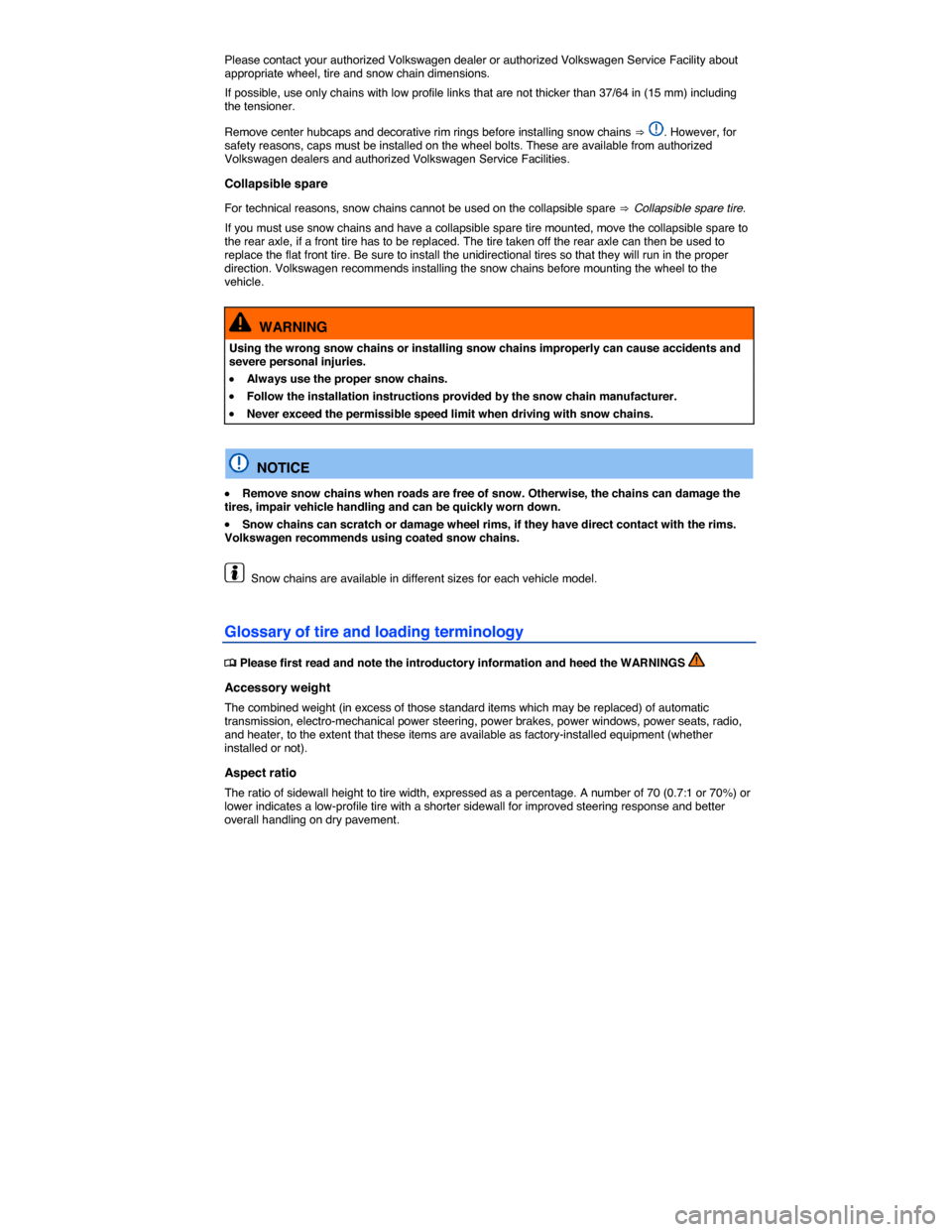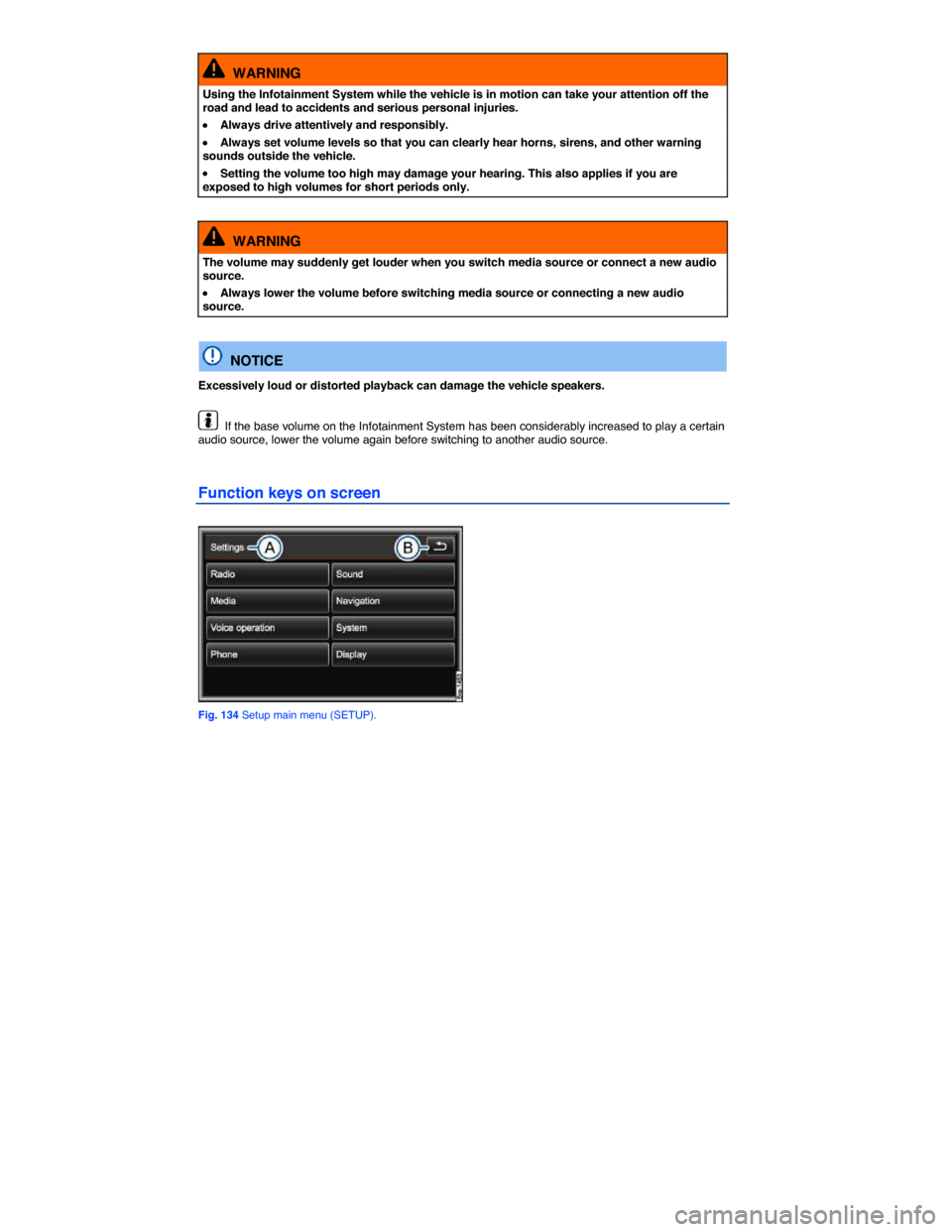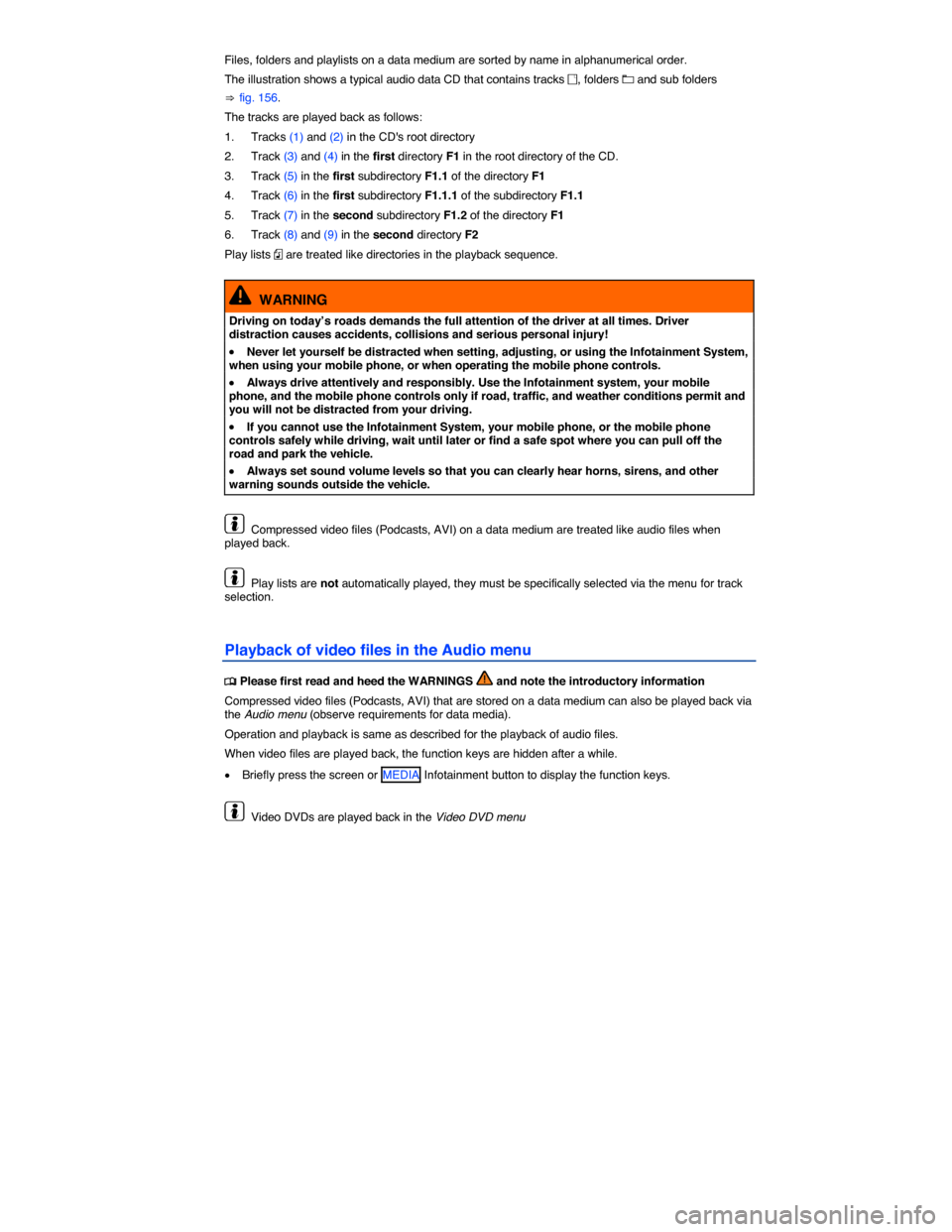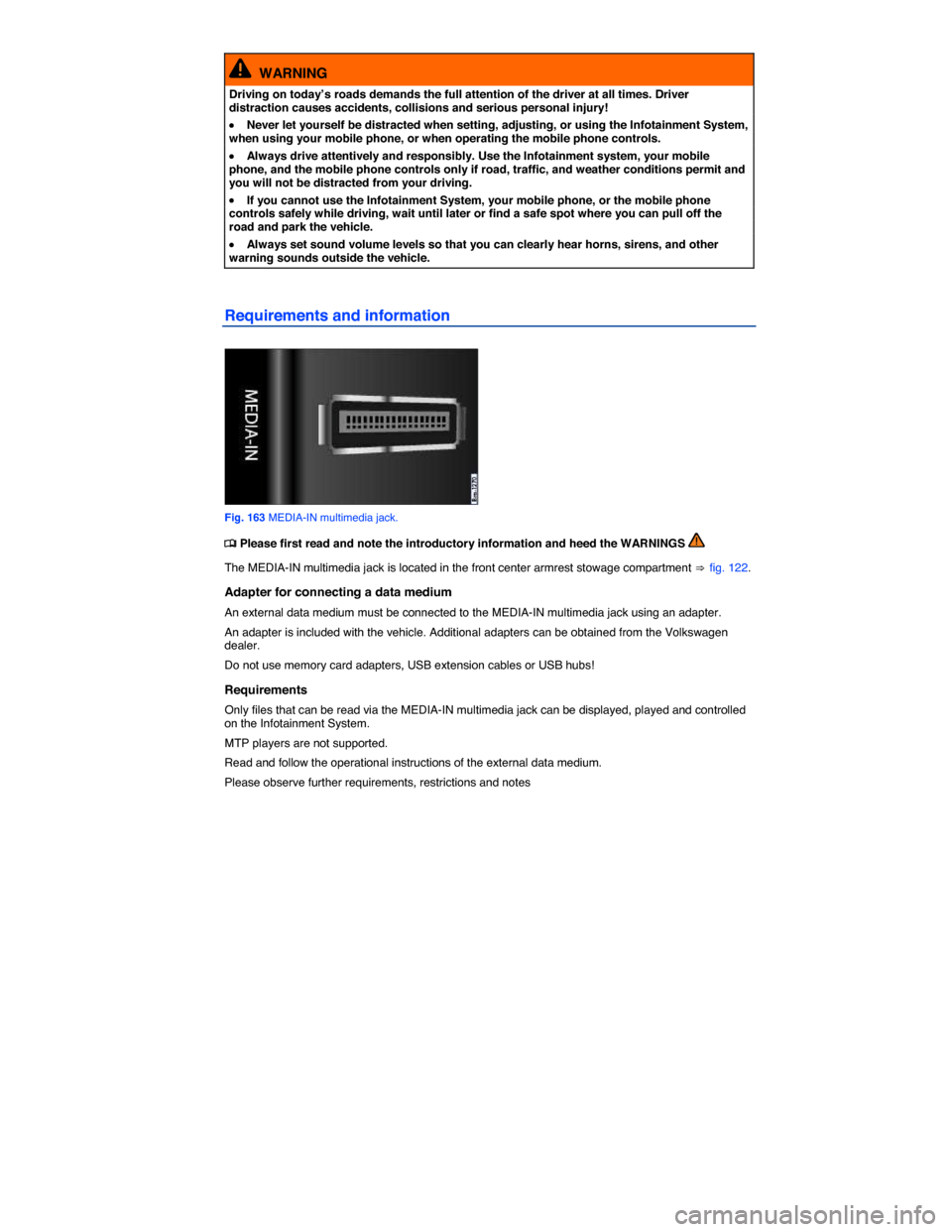2014 VOLKSWAGEN TOUAREG Off road
[x] Cancel search: Off roadPage 180 of 620

It takes several hours for the collapsible spare tire to return to its collapsed form after you let the air out of it. Once this has happened, you can put it back in the spare tire well and secure it.
�x Let the air out of the tire by unscrewing the valve core.
�x Screw the valve core back in once the air has been released.
�x Wait several hours before putting the collapsible spare tire back in the spare tire well.
�x Once the time is up, open the rear hatch. Lift up the luggage compartment floor panel and hook it to the top of the luggage compartment or remove the reversible luggage compartment floor panel
⇒ Luggage compartment.
�x Place the collapsible spare tire in the spare tire well and secure it with the fastening bolt (⇒ fig. 115 (2) or (3)).
�x Fit the retainer (1) back into the middle of the collapsible spare tire .
�x Unhook the luggage compartment floor panel/replace reversible luggage compartment floor panel.
�x Close the rear hatch.
WARNING
Improper use of a collapsible spare tire can cause loss of vehicle control, a crash or other accident, and serious personal injury.
�x Never use a collapsible spare tire if it is damaged or worn down to the wear indicators.
�x The collapsible spare tire is identified by a sticker and the words “50 mph” or “80 km/h”. This is the maximum permissible speed when driving with this tire.
�x Never drive faster than 50 mph (80 km/h) with a collapsible spare tire. Avoid full-throttle acceleration, heavy braking, and fast cornering!
�x Never drive more than 125 miles (200 km) if a compact spare wheel is installed on the front axle (drive axle).
�x Replace the collapsible spare tire with a normal wheel as soon as possible. Collapsible spare tires are designed for brief use only.
�x Regularly check U.S. DOT tire identification number (TIN) to determine the age of the
collapsible spare tire ⇒ Tire labeling. Tires age even if they are not being used and can fail suddenly, especially at higher speeds.
�x Tires that are more than 6 years old can only be used in an emergency and then with special care and at lower speeds.
�x The collapsible spare tire must always be secured with the wheel bolts provided by the factory.
�x Never drive using more than one collapsible spare tire.
�x After installing the collapsible spare tire, the tire pressure must be checked as soon as
possible ⇒ Tire inflation pressure.
�x Snow chains cannot be used on the collapsible spare tire. If you need the snow chains, but one of the front tires is flat, you have to mount the collapsible spare tire on the rear axle. The tire taken off the rear axle can then be used to replace the flat front tire. Be sure to maintain the tire's direction of rotation. Install the snow chains on the full-sized road wheel.
If possible, fasten the collapsible spare tire or the wheel you took off the vehicle securely in the luggage compartment. On vehicles equipped with a tire mobility set, the tire you took off the vehicle cannot be secured.
Page 185 of 620

All-wheel drive (4MOTION)
Vehicles with all-wheel drive and standard road wheels have good forward motion and traction even under wintery road conditions. However, Volkswagen recommends installing snow tires or all season tires on all 4 wheels to improve handling as well as braking performance.
If you use snow chains, please read and heed information and directions ⇒ Snow chains.
WARNING
Driving faster than the maximum speed for which the winter tires on your vehicle were designed can cause sudden tire failure including a blowout and sudden deflation, loss of control, crashes and serious personal injuries.
�x Winter tires have a maximum speed rating that may be lower than your vehicle's maximum speed.
�x Never drive faster than the maximum speed for which the winter tires installed on your vehicle are rated because tires that are driven faster than their rated speed can fail suddenly.
�x Never exceed the maximum load rating for the winter tires installed on your vehicle.
Install summer tires promptly in the spring. Summer tires offer better handling characteristics for temperatures above +45 °F (+7 °C). They are quieter, do not wear as quickly, and reduce fuel consumption.
If factory-installed wheels and/or tires are replaced when installing winter tires, make sure that the wheels are equipped with sensors that are compatible with the factory-installed Tire Pressure
Monitoring System and that the tires are also compatible with the system ⇒ Tire Pressure Monitoring System (TPMS). If new tires are not identical to those that were removed and require different cold tire inflation pressure, the tire inflation pressure values must be reprogrammed for the TPMS. Please see
your authorized Volkswagen dealer or authorized Volkswagen Service Facility ⇒ Tire Pressure Monitoring System (TPMS).
If necessary, ask your authorized Volkswagen dealer or authorized Volkswagen Service Facility about permissible winter tire dimensions.
Snow chains
�
Page 186 of 620

Please contact your authorized Volkswagen dealer or authorized Volkswagen Service Facility about appropriate wheel, tire and snow chain dimensions.
If possible, use only chains with low profile links that are not thicker than 37/64 in (15 mm) including the tensioner.
Remove center hubcaps and decorative rim rings before installing snow chains ⇒ . However, for safety reasons, caps must be installed on the wheel bolts. These are available from authorized Volkswagen dealers and authorized Volkswagen Service Facilities.
Collapsible spare
For technical reasons, snow chains cannot be used on the collapsible spare ⇒ Collapsible spare tire.
If you must use snow chains and have a collapsible spare tire mounted, move the collapsible spare to the rear axle, if a front tire has to be replaced. The tire taken off the rear axle can then be used to replace the flat front tire. Be sure to install the unidirectional tires so that they will run in the proper direction. Volkswagen recommends installing the snow chains before mounting the wheel to the vehicle.
WARNING
Using the wrong snow chains or installing snow chains improperly can cause accidents and severe personal injuries.
�x Always use the proper snow chains.
�x Follow the installation instructions provided by the snow chain manufacturer.
�x Never exceed the permissible speed limit when driving with snow chains.
NOTICE
�x Remove snow chains when roads are free of snow. Otherwise, the chains can damage the tires, impair vehicle handling and can be quickly worn down.
�x Snow chains can scratch or damage wheel rims, if they have direct contact with the rims. Volkswagen recommends using coated snow chains.
Snow chains are available in different sizes for each vehicle model.
Glossary of tire and loading terminology
�
Page 216 of 620

223
Safety information on Infotainment System
WARNING
Driving on today's roads demands the full attention of the driver at all times. Driver distraction causes accidents, collisions and serious personal injury!
�x Never let yourself be distracted when setting, adjusting, or using the Infotainment System, when using your mobile phone, or when operating the mobile phone controls.
�x Always drive attentively and responsibly. Use the Infotainment system, your mobile phone, and the mobile phone controls only if road, traffic, and weather conditions permit and you will not be distracted from your driving.
�x If you cannot use the Infotainment System, your mobile phone, or the mobile phone controls safely while driving, wait until later or find a safe spot where you can pull off the road and park the vehicle.
�x Always set sound volume levels so that you can clearly hear horns, sirens, and other warning sounds outside the vehicle.
�x Setting the sound volume too high may damage your hearing. This applies even if you are exposed to high volumes for short periods only.
WARNING
The volume level may suddenly get louder change when you switch media source or connect a new audio source.
�x Always lower the base volume before switching media source or connecting a new audio source.
WARNING
Driving recommendations and traffic symbols displayed by the navigation system may differ from the current traffic situation.
�x Traffic signs and traffic regulations have priority over the recommendations and displays provided by the navigation system.
�x Always adjust your speed and driving style to road, traffic, weather, and visibility conditions.
WARNING
External devices that are loose in the vehicle or not properly secured could be thrown around the interior and cause injuries during a sudden driving or braking maneuver, or in a crash.
�x Never put or attach an external device on a door, on the windshield or above or near to the areas marked “AIRBAG” on the steering wheel, the instrument panel and the seat backrests, or between these areas and the vehicle occupants. External devices could cause serious injury in an accident, especially when the airbags inflate.
Page 221 of 620

WARNING
Using the Infotainment System while the vehicle is in motion can take your attention off the road and lead to accidents and serious personal injuries.
�x Always drive attentively and responsibly.
�x Always set volume levels so that you can clearly hear horns, sirens, and other warning sounds outside the vehicle.
�x Setting the volume too high may damage your hearing. This also applies if you are exposed to high volumes for short periods only.
WARNING
The volume may suddenly get louder when you switch media source or connect a new audio source.
�x Always lower the volume before switching media source or connecting a new audio source.
NOTICE
Excessively loud or distorted playback can damage the vehicle speakers.
If the base volume on the Infotainment System has been considerably increased to play a certain audio source, lower the volume again before switching to another audio source.
Function keys on screen
Fig. 134 Setup main menu (SETUP).
Page 252 of 620

NOTICE
�x When inserting and removing CDs and DVDs, always hold them at right angles to the front of the unit. Inserting or removing them at an angle to the DVD drive may lead to scratching.
�x Inserting a second CD or DVD while a CD or DVD is inserted or is being ejected can destroy the DVD drive. Always wait until the data media is completely ejected.
NOTICE
Any foreign objects attached to a data medium and non-round data media can damage the DVD drive.
�x Only clean 12-cm standard CDs or DVDs should be used!
– Do not attach stickers or other items to the data medium. Stickers may peel off and damage the drive.
– Do not insert 8-cm single CDs or non-round CDs (shaped CDs) or DVDs.
– Do not insert DVD-Plus, Dual Discs and Flip Discs, as these are thicker than standard CDs.
CDs can also be played in a DVD drive if they meet the requirements
Uneven road surfaces and strong vibrations may cause CDs and DVDs being played in the DVD drive to jump.
If the temperature inside a DVD drive is too high, loading and playback of CDs and DVDs is disabled.
Data media and file requirements
�
Page 260 of 620

Files, folders and playlists on a data medium are sorted by name in alphanumerical order.
The illustration shows a typical audio data CD that contains tracks �B, folders �A and sub folders
⇒ fig. 156.
The tracks are played back as follows:
1. Tracks (1) and (2) in the CD's root directory
2. Track (3) and (4) in the first directory F1 in the root directory of the CD.
3. Track (5) in the first subdirectory F1.1 of the directory F1
4. Track (6) in the first subdirectory F1.1.1 of the subdirectory F1.1
5. Track (7) in the second subdirectory F1.2 of the directory F1
6. Track (8) and (9) in the second directory F2
Play lists �t are treated like directories in the playback sequence.
WARNING
Driving on today’s roads demands the full attention of the driver at all times. Driver distraction causes accidents, collisions and serious personal injury!
�x Never let yourself be distracted when setting, adjusting, or using the Infotainment System, when using your mobile phone, or when operating the mobile phone controls.
�x Always drive attentively and responsibly. Use the Infotainment system, your mobile phone, and the mobile phone controls only if road, traffic, and weather conditions permit and you will not be distracted from your driving.
�x If you cannot use the Infotainment System, your mobile phone, or the mobile phone controls safely while driving, wait until later or find a safe spot where you can pull off the road and park the vehicle.
�x Always set sound volume levels so that you can clearly hear horns, sirens, and other warning sounds outside the vehicle.
Compressed video files (Podcasts, AVI) on a data medium are treated like audio files when played back.
Play lists are not automatically played, they must be specifically selected via the menu for track selection.
Playback of video files in the Audio menu
�
Page 270 of 620

WARNING
Driving on today’s roads demands the full attention of the driver at all times. Driver distraction causes accidents, collisions and serious personal injury!
�x Never let yourself be distracted when setting, adjusting, or using the Infotainment System, when using your mobile phone, or when operating the mobile phone controls.
�x Always drive attentively and responsibly. Use the Infotainment system, your mobile phone, and the mobile phone controls only if road, traffic, and weather conditions permit and you will not be distracted from your driving.
�x If you cannot use the Infotainment System, your mobile phone, or the mobile phone controls safely while driving, wait until later or find a safe spot where you can pull off the road and park the vehicle.
�x Always set sound volume levels so that you can clearly hear horns, sirens, and other warning sounds outside the vehicle.
Requirements and information
Fig. 163 MEDIA-IN multimedia jack.
�